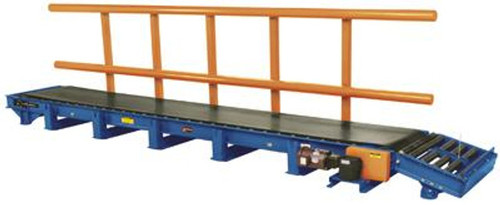FOB Midwest Warehouse
Roach's EZ-WEIGH® Bale Conveyors are the most complete - and preferred - bale conveyor for conveying hay bales.
Operation:
- EZ-WEIGH® No. 2: a 4-strand chain cotton conveyor with shocks, receives bales from the feeder.
- Bale is "laid" onto this unit for horizontal conveying where it is tagged and conveyed onto the scale conveyor.
- Four heavy duty shock absorbers cushion the fall of the bale.
Make Roach your number one Bale Handling Cotton Conveyor choice.
The scale conveyor, EZ-WEIGH® No. 3, is mounted on top of a scale. The bale is indexed onto this conveyor, where it is weighed and held until operator records individual bale weight information.
More Bale Conveyor Features:
- EZ-WEIGH® No. 4: an inclined belt conveyor that may be used in bale handling applications not featuring a bagger assembly.
- Conveyor inclines bale into position for transfer to the No. 5 accumulator.
- EZ-WEIGH® No. 5: bale handling electric accumulator that receives bales from bagger conveyor (or from EZ-WEIGH®® No. 4, an inclined belt conveyor).
- Bales tip over into upright position and are accumulated by the No. 5 unit.
- Chain driven powered pusher arm moves several accumulated bales to provide clearance for another bale.
- Inline bagger and dual chain conveyors place bags on bales.
- 2-strand chain conveyor feeds bale to the bagger funnel.
- Chain driven pusher or ram directs bale through bagger funnel assembly where a poly bag covers bale for protection in shipping and storage.
- Another 2-strand chain conveyor powers bale onto the electric accumulator.
The manual sample cutter allows the operator to remove and tag a sample from the bale. When the bales move into position, an operator directs the bale cutter module to move into the bale. The blade carriage is repositioned left or right to avoid sample cutter blades hitting metal bands when cutting the sample. The bale cutter blade is driven down to cut samples from both sides of bale. The cutter assembly returns to original position and bale advances from the manual sample cutter.









